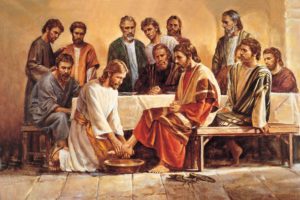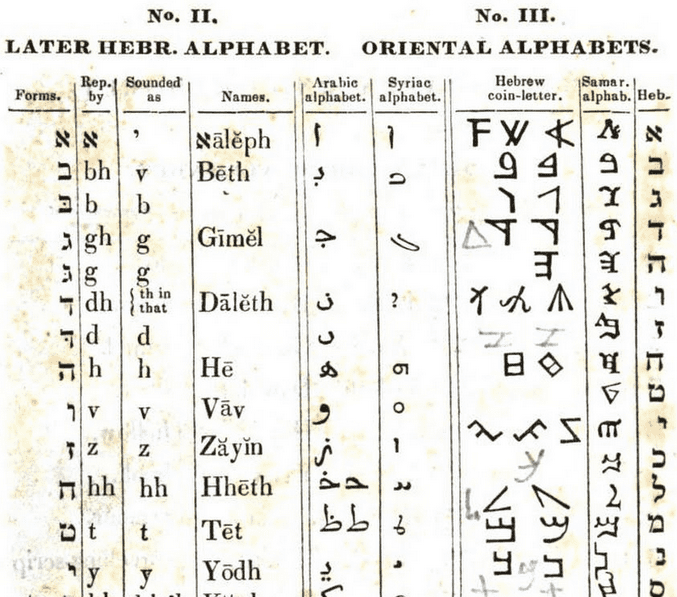
In my exploration of the “arise from the dust” theme in the Book of Mormon, published in several articles for Interpreter: A Journal of Latter-day saint Faith and Scholarship (see “Arise from the Dust,” Part 1, Part 2, Part 3, and “Strong Like Unto Moses“) and the topic of my 2018 presentation at the FAIR Latter-day Saints Conference, I noted that passages from Isaiah 49 and Isaiah 52 play an important role in the Book of Mormon. Both involve the theme of dust:
Thus saith the Lord GOD, Behold, I will lift up mine hand to the Gentiles, and set up my standard to the people: and they shall bring thy sons in their arms, and thy daughters shall be carried upon their shoulders.
And kings shall be thy nursing fathers, and their queens thy nursing mothers: they shall bow down to thee with their face toward the earth, and lick up the dust of thy feet; and thou shalt know that I am the LORD: for they shall not be ashamed that wait for me. (Isaiah 49: 22-23)
Awake, awake; put on thy strength, O Zion; put on thy beautiful garments, O Jerusalem, the holy city: for henceforth there shall no more come into thee the uncircumcised and the unclean.
Shake thyself from the dust; arise, and sit down, O Jerusalem: loose thyself from the bands of thy neck, O captive daughter of Zion. (Isaiah 52: 1-2)
Isaiah 52 is especially important, and is used multiple times in the Book of Mormon. The theme of rising from the dust here involves the concept of keeping the covenant and receiving the blessing of enthronement. Indeed, after one rises from the dust and shakes off the dust, a symbol of death and sin (breaking the covenant), the commands to “sit down” does not mean to sit down in the dust, but on one’s throne, receiving power and authority from the Heavenly King. Rising from the dust is not just a symbol of life and resurrection, but also pertains to covenant keeping and receiving authority or enthronement, a fascinating connection that was noted by Walter Brueggemann in “From Dust to Kingship,” Zeitschrift für die alttestamentliche Wissenschaft, 84/1 (1972): 1–18. The Book of Mormon artfully employs such themes in ways that are consistent with the modern scholarship of Brueggemann and others, scholarship that was not available to Joseph Smith and his technical advisory team, no matter how vast their secret frontier library was.
Isaiah 52 goes on with related themes, pointing to the covenant relationship between Israel and God (His people shall know His name), the beauty of the feet (cleansed from dust) upon the mountains of those who publish salvation, and the blessings of protection and salvation to those who keep the covenant:
Therefore my people shall know my name: therefore they shall know in that day that I am he that doth speak: behold, it is I.
How beautiful upon the mountains are the feet of him that bringeth good tidings, that publisheth peace; that bringeth good tidings of good, that publisheth salvation; that saith unto Zion, Thy God reigneth!
Thy watchmen shall lift up the voice; with the voice together shall they sing: for they shall see eye to eye, when the LORD shall bring again Zion.
Break forth into joy, sing together, ye waste places of Jerusalem: for the LORD hath comforted his people, he hath redeemed Jerusalem.
The LORD hath made bare his holy arm in the eyes of all the nations; and all the ends of the earth shall see the salvation of our God.
Depart ye, depart ye, go ye out from thence, touch no unclean thing; go ye out of the midst of her; be ye clean, that bear the vessels of the LORD.
For ye shall not go out with haste, nor go by flight: for the LORD will go before you; and the God of Israel will be your rereward. (Isaiah 52: 6-12)
The good news of that latter passage was misunderstood by the wicked priests of King Noah as good news for them in spite of their wickedness, and this was viewed as an excellent “gotcha” passage to trip up Abinadi with his seemingly gloomy message of repentance. The choice of that question once puzzled me, as did Abinadi’s seemingly unrelated or rambling response, until I viewed it through the lens of the complex of covenant-related concepts associated with the rich theme of “arise from the dust” in the Book of Mormon, as I discuss in “‘Arise from the Dust’: Insights from Dust-Related Themes in the Book of Mormon (Part 2: Enthronement, Resurrection, and Other Ancient Motifs from the ‘Voice from the Dust’),” pp. 247-249.
Isaiah 49 points to the aid from the Gentiles in gathering Israel. Kings and queens licking the dust off the feet of scattered Israel is a beautiful image conveying the humbling of the mighty before Israel but also invokes the image of purification and keeping the covenant as dust is removed from Israel’s feet. This passage is cited twice in Nephi’s writings in short succession, forming the outer brackets of an important inclusio (related to a chiasmus) in the Book of Mormon that surrounds Lehi’s impassioned farewell speech in 2 Nephi 1 as the aging father draws upon Isaiah 52 to call his sons to awake and arise from the dust. (See “Arise from the Dust,” Part 2, pages 254-263.)
While I find the Book of Mormon’s use of the “arise from the dust” theme to provide compelling evidence for its ancient origins, one can object that the Book of Mormon is using passages of Isaiah from the latter chapters of Isaiah that are commonly attributed to “Deutero-Isaiah” and said to be written after the Exile, thus being anachronistic in Nephi’s writings. I briefly address the claims that Isaiah 40 and beyond must have been written after the Exile in “‘Arise from the Dust’: Insights from Dust-Related Themes in the Book of Mormon (Part 1: Tracks from the Book of Moses),” pages 197-199:
A Note on the Book of Mormon and Deutero-Isaiah
One can easily object to the influence of Isaiah 52, noted above, as source for dust-related imagery and language in the Book of Mormon. The problem is that many scholars believe that Isaiah chapters 40–55 were written by a second author, called “Deutero-Isaiah” or “Second Isaiah,” during or after the Exile, and thus that part of the text could not have been on Nephi’s brass plates. A detailed treatment of this issue is beyond the scope of this paper, but there are reasonable grounds for accepting Isaiah as the author of those chapters commonly assigned to a much later source. Richard Schultz, Professor of Biblical Studies at Wheaton College, presents some of these reasons.33
Kenneth A. Kitchen also makes a brief case for the unity of Isaiah in On the Reliability of the Old Testament,34 pointing to evidence from an Isaiah manuscript in the Dead Sea scrolls in which the full book of Isaiah is written with a division at the end of chapter 33, as if it were viewed as a book with two related halves. The parallelism between these two halves was long ago analyzed by W.H. Brownlee and said to be indicative of an overarching literary structure pointing to unity.35 Brownlee calls the structure the “Bifid” format of Isaiah, consisting of seven broad parallel sections in both halves. This approach was taken up and greatly refined by Avraham Gileadi in The Literary Message of Isaiah.36 Gileadi provides a reworked “Bifid structure” of seven parallel elements and shows broad themes with detailed parallels that strongly unite the entire book of Isaiah in a work whose detailed scholarship has been praised by non LDS and LDS scholars.37
The unity of Isaiah was apparently not questioned by the Qumran community in 200 bc nor by New Testament voices, Christ included, who quote from the latter portions of Isaiah as writings of Isaiah and not a later author (e.g., Matthew 12:17, quoting Isaiah 42:1–4, which Christ attributes to Isaiah; and Matthew 8:16–17, quoting Isaiah 53:4, which Christ attributes to Isaiah; see also John 12:37–41, which quotes from Isaiah 53:1 and then Isaiah 6:10, identifying both passages as from Isaiah).
A discussion of the issues for Book of Mormon students is provided by John W. Welch in Isaiah in the Book of Mormon, concluding that portions of Isaiah quoted were probably on the brass plates and most likely authored by Isaiah.38 Welch observes that there are reasonable grounds for accepting the unity of the version of Isaiah on the brass plates, though it may not have included the full book as we know it today. He also notes that the parts viewed as most strongly post-exilic by modern scholars, often ascribed to a “Tertio-Isaiah,” are not quoted in the Book of Mormon.39
Some wordprint and other statistical or scientific studies have also pointed to unity in Isaiah or at least have not provided support for multiple authorship.40
I would further argue that the sophisticated application of dust related themes in the Book of Mormon drawing heavily on Isaiah 52 — to be explored more fully in Parts 2 and 3 — is something far beyond Joseph Smith’s abilities or perhaps even the state of biblical scholarship in Joseph’s day and helps make the Book of Mormon itself a witness for the authenticity of the later Isaiah chapters quoted or relied upon in the Book of Mormon.
In addition, one might add that the dust-related passages of Isaiah 49 and 52 also seem to show unity with passages prior to Isaiah 40, the purported beginning of Deutero-Isaiah’s work. Isaiah 26, for example, has the joyful message of protection and deliverance found in Isaiah 52, and twice refers to dust. After the announcement of a victory song and the opening of the gates “that the righteous nation which keepeth the truth may enter in” in verses 1-2, the lofty city of Israel’s enemies will be brought down “even to the ground; he bringeth it even to the dust” in verse 5, and “the foot shall tread it down, even the feet of the poor, and the steps of the needy” in verse 6. After this victory for Israel, we read of the blessed state of those keeping the covenant:
Yea, in the way of thy judgments, O LORD, have we waited for thee; the desire of our soul is to thy name, and to the remembrance of thee.
With my soul have I desired thee in the night; yea, with my spirit within me will I seek thee early: for when thy judgments are in the earth, the inhabitants of the world will learn righteousness. (Isaiah 26: 8-9)
Israel has been afflicted and suffered great pain, but eternal blessings await, even the miracle of resurrection for those who have been slain:
We have been with child, we have been in pain, we have as it were brought forth wind; we have not wrought any deliverance in the earth; neither have the inhabitants of the world fallen.
Thy dead men shall live, together with my dead body shall they arise. Awake and sing, ye that dwell in dust: for thy dew is as the dew of herbs, and the earth shall cast out the dead.
Come, my people, enter thou into thy chambers, and shut thy doors about thee: hide thyself as it were for a little moment, until the indignation be overpast.
For, behold, the LORD cometh out of his place to punish the inhabitants of the earth for their iniquity: the earth also shall disclose her blood, and shall no more cover her slain. (Isaiah 26: 18-21)
Awake and sing, you that dwell in the dust, for you shall rise again. Israel shall be redeemed and have cause to sing for joy as the Lord topples the wicked across the earth and redeems Zion. This resonates so well with Isaiah 52: “Awake, awake; put on thy strength, O Zion” (vs. 1); “Shake thyself from the dust; arise, and sit down, O Jerusalem: loose thyself from the bands of thy neck, O captive daughter of Zion” (vs. 2); “Break forth into joy, sing together, ye waste places of Jerusalem: for the LORD hath comforted his people, he hath redeemed Jerusalem” (vs. 9); and “The LORD hath made bare his holy arm in the eyes of all the nations; and all the ends of the earth shall see the salvation of our God” (vs. 10).
Isaiah 26 seems closely related in its tone and themes to Isaiah 52, suggesting that Isaiah 26 and 52 are part of an integral work. That connection is one of many pointing to the unity of the portions of Isaiah that are cited in the Book of Mormon.
The theme of affliction followed by restoration and joyful redemption is also found in Isaiah 29, which prophesies about a voice whispering to us from the dust:
And thou shalt be brought down, and shalt speak out of the ground, and thy speech shall be low out of the dust, and thy voice shall be, as of one that hath a familiar spirit, out of the ground, and thy speech shall whisper out of the dust. (Isaiah 29:4)
In a time of apostasy, lacking prophets and vision, a marvelous work will be brought forth that involves what we sometimes call the “voice from the dust,” the Book of Mormon:
For the LORD hath poured out upon you the spirit of deep sleep, and hath closed your eyes: the prophets and your rulers, the seers hath he covered.
And the vision of all is become unto you as the words of a book that is sealed, which men deliver to one that is learned, saying, Read this, I pray thee: and he saith, I cannot; for it is sealed:
And the book is delivered to him that is not learned, saying, Read this, I pray thee: and he saith, I am not learned.
Wherefore the Lord said, Forasmuch as this people draw near me with their mouth, and with their lips do honour me, but have removed their heart far from me, and their fear toward me is taught by the precept of men:
Therefore, behold, I will proceed to do a marvellous work among this people, even a marvellous work and a wonder: for the wisdom of their wise men shall perish, and the understanding of their prudent men shall be hid. (Isaiah 29:10-14)
That “voice from the dust” is part of the joyous news of Restoration and the modern work of the gathering of Israel. It helps us know how to shake ourselves from the dust and keep the covenants of the Lord, that we might be invited to receive the blessings of the temple, robed in sacred clothing, singing songs of joy, and brought into the presence of the Lord. It should be a mighty tool that we use more to further the work of the Lord and to bring joy to our own lives. It truly is part of a great and marvelous work that needs more attention and gratitude from all of us. It is a witness for the Messiah and for the truths of the Bible, including the prophecies of Isaiah.
The Book of Mormon’s use of the subtle and far-ranging “arise from the dust” theme comports beautifully with modern scholarship in ways that Joseph Smith could not have fabricated based on Bible scholarship in his day. This not only adds to the evidence for the plausibility and antiquity of the Book of Mormon, but incidentally strengthens the case for the pre-exilic origins of at least several chapters often ascribed to Deutero-Isaiah, and thus strengthens the case for the unity of Isaiah and Deutero-Isaiah. The Book of Mormon is not only another witness of Jesus Christ, but a witness for the Holy Bible that can help resolve some disputes about its origins.
Update, Sept. 4, 2022: Recently Robert Boylan, author of the outstanding Scriptural Mormonism blog, kindly interviewed me about my investigations of the “Arise from the Dust” theme for his periodic podcast. You can see the video in his post, “Episode 13: Jeff Lindsay on ‘Arise from the Dust’.” He briefly raised the issue of Second Isaiah and noted that Margaret Barker had a solid peer-reviewed article with some valuable insights relevant to Isaiah 52 and 53. The article was originally published as Margaret Barker, “Hezekiah’s Boil,” Journal for the Study of the Old Testament 26, no. 1 (September 2001): 31-42, DOI: 10.1177/030908920102600102. Fortunately, the article, or a form of it, is available on her website, MargaretBarker.com, as “The Original Setting of the Fourth Servant Song” (2000). You can also find it on her list of publications at http://www.margaretbarker.com/Papers/default.htm. Here is the abstract from the JSOT publication, which is not included in the PDF on her site:
Hezekiah had a potentially fatal boil which suggests that he had bubonic plague. This also destroyed the Assyrian army threatening Jerusalem. The king made a miraculous recovery. Isaiah first predicted that the king would die for his sin (of destroying the high places) but he then promised recovery. The prophet’s two explanations of the king’s suffering inspired the Fourth Servant Song, which depicted the suffering servant first as a sinner and then as the sin bearer. This is evidence for a sin-bearing priest-king, and for Isaiah’s hostility to the so-called ‘reforms’ of the cult. Evidence from Lachish and ancient eclipses supports this reconstruction, and so calls into question the suggestion that it was a later fiction.
Barker makes a plausible case that the story of Hezekiah’s illness and his recovery, as described in Isaiah 38 (a chapter attributed to First Isaiah/Proto-Isaiah), is directly related to the Fourth Servant Song in Isaiah 53, where Isaiah refers to Hezekiah as the afflicted servant. I would add that at the same time, of course, Isaiah prophetically paints a magnificent picture of the role of the Messiah in his treatment of Hezekiah’s situation. She provides an interesting combination of textual evidence and external data in support of her proposal, which significantly strengthens the case that Isaiah 53 was the product of First Isaiah. Isaiah 52 is closely related to Isaiah 53, setting the stage for the Fourth Servant Song. If Isaiah 53 dates back to the time of First Isaiah, it is likely that Isaiah 52 does as well.












Thank you for offering your perspective on “arise from the dust”.